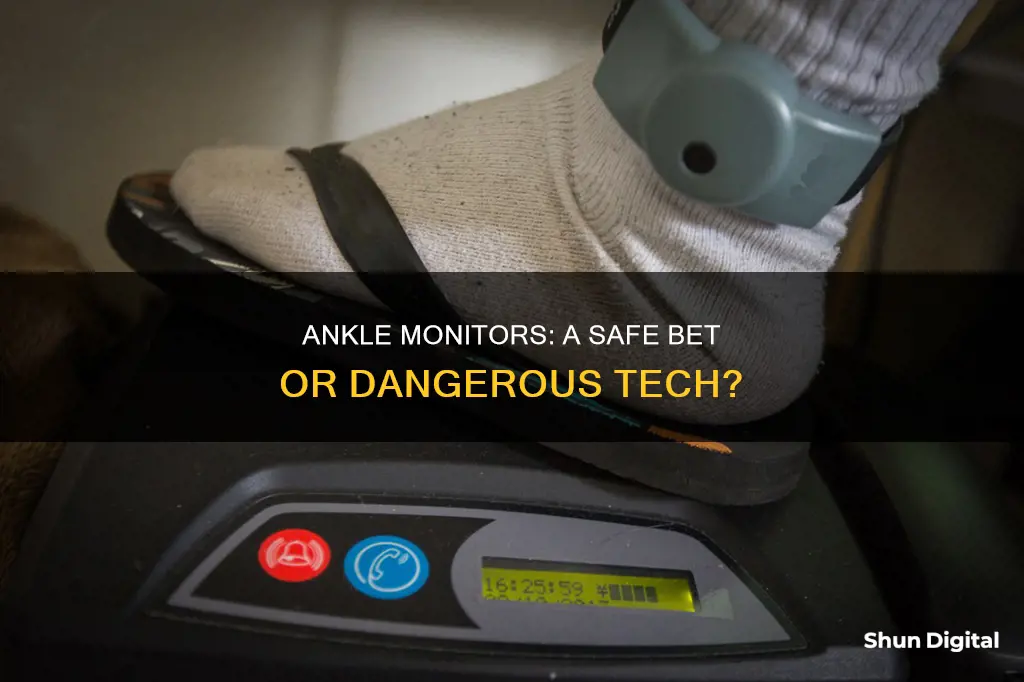
Electronic ankle monitors have been used as an alternative to incarceration since the 1980s. They are typically used to track the movements of individuals who have been sentenced to restricted travel or activities. While they are intended to reduce prison populations, critics argue that they are ineffective at reducing recidivism and can create a false sense of security. Additionally, the cost of these devices is often passed on to the wearer, creating a financial burden. Furthermore, the bulky and conspicuous design of ankle monitors has been linked to stigma and social isolation, raising concerns about the ethics and potential for discrimination.
| Characteristics | Values |
|---|---|
| Use | Ankle monitors are used as an alternative to incarceration, as part of bail or probation conditions, and in immigration contexts. |
| History | The first commercial applications of ankle monitors were in the 1980s. |
| Effectiveness | There is no empirical evidence that ankle monitors are rehabilitative. However, a 2006 study of 75,661 Florida offenders found that those wearing ankle monitors were 91.2% less likely to abscond and 94.7% less likely to commit new offences. |
| Stigma | Ankle monitors are bulky and difficult to conceal, displaying their wearers' involvement with the justice system. This can lead to stigmatisation and invite prejudice. |
| Cost | The cost of ankle monitors is often passed on to the people wearing them, ranging from $2 to $20 per day, with additional activation fees in some counties. |
| Technical Issues | Ankle monitors can experience technical glitches, leading to false violations. |
What You'll Learn
- Ankle monitors can lead to false accusations and technical glitches
- They can be expensive for the wearer, costing hundreds of dollars per month
- They may not be effective in preventing crime
- They can cause physical discomfort and restrict movement
- They can be a form of public shaming, inviting prejudice and social isolation

Ankle monitors can lead to false accusations and technical glitches
Ankle monitors have been used as an alternative to incarceration since the 1980s. They are typically used to enforce house arrest, or to keep people within a certain radius. However, there are several issues with this technology. Firstly, the design of ankle monitors has not changed significantly in 30 years, and they are bulky and difficult to conceal. This means that the wearer's potential involvement with the justice system is on display for all to see. This can lead to prejudice and false accusations, as people often presume that the wearer is a dangerous criminal. The stigma associated with ankle monitors can also make it difficult for individuals to form social bonds or obtain employment.
In addition to the social implications, there are also technical issues with ankle monitors. For example, they can be subject to false violations and technical glitches, particularly those that rely on GPS tracking. In one instance, a man was charged with escaping custody because he was late returning home from work and had to charge his monitor. Ankle monitors can also be expensive, with daily fees ranging from $2 to $20 in some areas, on top of activation fees. This can place a significant financial burden on individuals, especially those who have lost their jobs or are already struggling financially.
Furthermore, there is concern that the use of ankle monitors may expand mass incarceration, rather than reduce it. Minor technical violations, charging malfunctions, and false alarms can lead people back to physical jails and prisons. This is especially true for youth offenders, who may be incarcerated for technical violations such as going to the store or seeing friends at the park. In some cases, individuals may choose to cut off their monitors because they can't bear the restrictions and constant surveillance any longer.
While ankle monitors can provide an alternative to incarceration, it is important to consider the potential drawbacks and negative consequences associated with their use. The social stigma, technical glitches, and financial burden of ankle monitors can lead to false accusations and further entrenchment in the criminal justice system.
Oxygen Saturation Monitor: Should You Buy One?
You may want to see also

They can be expensive for the wearer, costing hundreds of dollars per month
The cost of ankle monitors can be a significant burden for those who have to wear them, with fees ranging from $3 to $35 per day, plus initial setup charges of up to $200. These costs can quickly add up to hundreds of dollars per month, creating a financial strain for individuals and families, especially those who are already dealing with the return of a loved one from incarceration.
In some cases, the cost of the ankle monitor is passed on to the wearer, who may be required to pay the daily fee as well as activation and other associated costs. This can lead to difficult choices between paying rent or monitor fees, and for those who lose their jobs or face financial difficulties, these costs can become overwhelming. In recognition of this burden, some jurisdictions, like Baltimore County, Maryland, have moved to eliminate ankle monitor fees altogether.
The high cost of ankle monitors is particularly concerning given the lack of evidence that they are effective in reducing recidivism or promoting rehabilitation. Researchers who study recidivism argue that ankle monitors may actually hinder individuals' efforts to rebuild their lives after prison, and there are concerns that the use of these monitors expands mass incarceration and leads to further punishment for minor technical violations.
The financial burden of ankle monitors is not limited to the devices themselves. Those who wear them may also face restrictions on their movement and activities, making it difficult to work or attend school. This can result in lost income and further contribute to the financial strain caused by the monitors.
Overall, the high cost of ankle monitors, coupled with the potential negative impact on individuals' ability to work and maintain their livelihoods, underscores the need for alternative approaches that are less restrictive and more effective in supporting individuals' reintegration into society.
Eliminating Monitor Delay in Adobe Audition: A Comprehensive Guide
You may want to see also

They may not be effective in preventing crime
Ankle monitors may not be effective in preventing crime. While they are designed to track the movements of individuals and enforce house arrest, there is no evidence that they reduce recidivism or promote rehabilitation. Instead, they may create a false sense of security and lead to a cycle of incarceration for minor technical violations.
The use of ankle monitors has been on the rise, especially during the COVID-19 pandemic, as an alternative to incarceration. However, researchers who study recidivism argue that ankle monitors do not address the systemic issues that contribute to criminal behaviour, such as unemployment, poverty, and structural racism. Instead, they may create a false sense of security and lead to a cycle of incarceration for minor technical violations, such as charging the device or evacuating during a fire.
Furthermore, ankle monitors can be expensive, with daily fees ranging from $2 to $20, and setup charges of up to $200. These costs are often passed on to the individuals wearing the monitors, creating a financial burden, especially for those who have lost their jobs or are struggling with unemployment benefits.
In addition, ankle monitors are bulky and difficult to conceal, displaying the wearer's involvement with the justice system. This can lead to stigma and prejudice, compromising privacy and potentially affecting employment opportunities. The design of these monitors has not significantly changed in 30 years, suggesting that the stigma and difficulty of hiding them may be intended as part of the punishment.
While ankle monitors can provide an alternative to incarceration, they do not address the underlying issues that contribute to criminal behaviour. Without addressing these issues, ankle monitors may not effectively prevent crime and may instead create a cycle of incarceration for minor technical violations.
Minimizing QBO Pages: Tips for Reducing Size on Your Monitor
You may want to see also

They can cause physical discomfort and restrict movement
Ankle monitors can cause physical discomfort and restrict the movement of those who wear them. The devices are typically strapped tightly around the lower leg, and their bulky design can make them difficult to conceal. This can lead to feelings of shame and social isolation, as they publicly display the wearer's involvement with the justice system.
The physical discomfort caused by ankle monitors can be significant. For example, Shannan Davis, a 43-year-old Native American woman, reported that the monitor was so tight it caused her muscles to contract and felt like it was going to break her skin. Evelyn Canal, a young woman from California, shared a similar experience, stating that the monitor was secured so tightly it cut into her skin and caused lacerations.
The restrictions on movement imposed by ankle monitors can also cause significant disruption to daily life. Wearers may be confined to their homes or limited to pre-approved locations, making it difficult to attend school, work, or social activities. This can hinder their efforts to rebuild their lives and reconnect with their communities after prison. Michael Tafolla, a 42-year-old man from Chicago, described the challenges he faced in adjusting his approved movement hours to accommodate his internship and job.
The financial burden of ankle monitors can also restrict movement and limit opportunities. In at least 30 states in the US, individuals are required to pay daily fees ranging from $2 to $20 to wear the devices, in addition to activation and setup charges. These costs can amount to hundreds of dollars per month, creating a significant financial strain, especially for those who have recently lost their jobs or are struggling with unemployment benefits.
The physical discomfort, restricted movement, and financial burden associated with ankle monitors can have detrimental effects on the well-being and rehabilitation of those who wear them. While the devices are intended as an alternative to incarceration, they can create a different set of challenges and hardships for individuals trying to reintegrate into society.
Tracking Techniques: Monitor Size Surveillance
You may want to see also

They can be a form of public shaming, inviting prejudice and social isolation
Ankle monitors have been criticised for being a form of public shaming, inviting prejudice and social isolation. The devices are often bulky and difficult to conceal, displaying their wearer's involvement with the justice system. This can lead to people making presumptions about the wearer's criminality and dangerousness, even if they are only wearing the monitor as an alternative to bail or due to COVID-19 exposure.
The monitors are often associated with criminal offenders, but they have also been used for people involved with the immigration system. This links to a long history of shaming people, such as the metal masks medieval women convicted of being "nags" were forced to wear, or the yellow armbands employed by the Nazis.
The design of ankle monitors has not changed significantly in 30 years, suggesting that the stigma of wearing them and the difficulty of hiding them could be intended as part of the punishment. This is in contrast to other wearable technology, such as smartwatches, which are designed to be less conspicuous. The conspicuous nature of ankle monitors can lead to social isolation and complicate privacy, jeopardising opportunities to form social bonds or obtain employment.
The surveillance devices can also hurt people trying to get their lives back on track after prison, keeping them connected to the prison system longer and dragging them deeper into the criminal justice system. For example, one wearer recounted how they were not allowed to leave their house to take out the trash without violating their house arrest, and another described the stress and panic attacks caused by the complicated process of adjusting their approved movement hours.
Replacing Capacitors in LCD Monitors: A Step-by-Step Guide
You may want to see also
Frequently asked questions
Ankle monitors are not physically dangerous, but they do pose a risk to the privacy and mental health of those who wear them.
Ankle monitors are electronic devices that are affixed to a person's lower leg. They use GPS and Wi-Fi to track the wearer's location and enforce house arrest or keep them within a certain radius.
Ankle monitors are used by law enforcement to monitor people who are on bail, probation, or parole, as well as those involved with the immigration system. They are also sometimes used as an alternative to bail for people awaiting trial.
There are several concerns with ankle monitors. Firstly, they are bulky and difficult to conceal, which can stigmatize and shame the wearer, displaying their potential involvement with the justice system. Secondly, the data collected by ankle monitors raises privacy issues, as it can be accessed by law enforcement and used to track and surveil individuals. Finally, there is no evidence that ankle monitors are effective in reducing recidivism or rehabilitating offenders. Instead, they may hurt people trying to rebuild their lives after prison and lead to further incarceration for minor technical violations.







